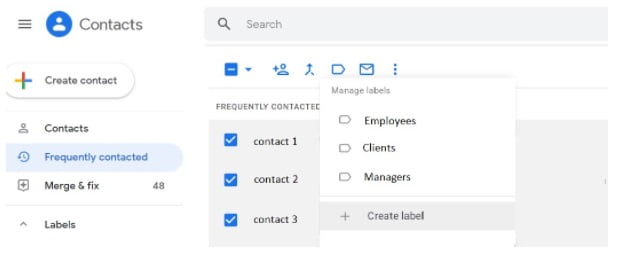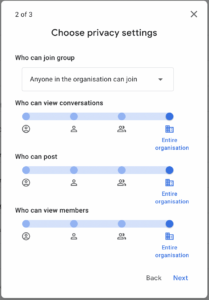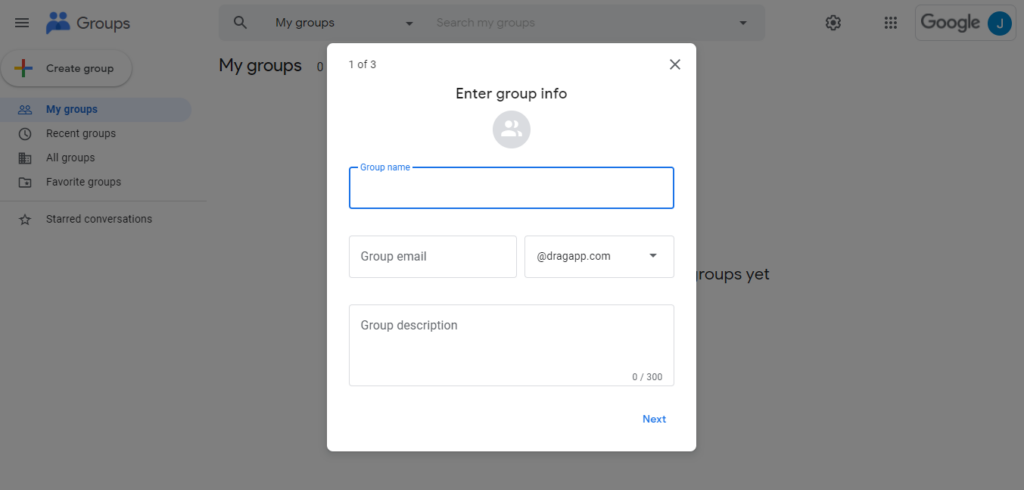
Email communication has become an integral part of modern business and personal communication. Whether it’s to communicate with clients, colleagues, or friends, sending emails has become a daily routine for most people. However, when you’re dealing with large groups of people, sending emails individually can be time-consuming and inefficient. That’s where knowing how to create a distribution list in Gmail or a Group in Gmail comes in.
Gmail groups are an excellent way to streamline your email communication and save time. Instead of sending emails to individual addresses, you can create a group and add all the relevant email addresses to it. This way, you can send emails to the entire group at once, saving you time and hassle.
But that’s just part of the benefits. The business owner that knows how to create a group in Gmail also provides other advantages, such as better organization and improved communication. By creating groups based on different criteria, such as departments, project teams, or client types, you can better categorize your contacts and ensure that the right people are receiving the right information.
In this article, we’ll explore the importance of Gmail groups and how to create them. The different types of groups you can create, the benefits each of them has and the steps to create your own groups.
The difference between Contact Groups in Gmail and Google Groups
Both Google Groups and contact groups in Gmail are ways to send email to a group of people, but they have some differences. The main ones being purpose and functionality.
A contact group in Gmail is a collection of email addresses that you can use to easily send messages to multiple recipients at once. They are useful for sending emails to a specific group of people, such as your coworkers or suppliers, without having to manually add each email address every time you compose a message. Contact groups are managed within the Gmail Contacts app and can only be used for sending emails.
A Google Group is an online discussion forum that can be used for email communication. Google Groups can be used for a variety of purposes, such as for organizing departments, conducting meetings, or discussing topics. Google Groups also allow members to manage their own settings. How often they get notified of new messages, for instance. This allows people to have more control over email threads on their Gmail inbox.
So, while a contact group in Gmail is a simple collection of email addresses used for sending messages, a Google Group is a more complex tool for online communication and collaboration.
How Contact Groups are used
A contact group, which is also known as a contact list or distribution list, allows you to categorize your email recipients. These are useful for quick, to-the-point messages.
Think, for example, of a contact group made from your most frequent buyers. If you have them all labeled as a contact group in Gmail, it’s much easier to send offers and notify them of new products.
There are other opportunities to use them, such as a group for team member to send memos, a group for suppliers and other companies, between others. The key is knowing how to create a group in Gmail that caters to your needs.
How Google Groups are used
As for Google Groups, they are great for ongoing communication. Since they work as a digital collective space, they allow for multiple threads, file sharing and much more. Some of the features they support are:
Discussion threads
Google Groups can be used as an online discussion forum, allowing employees to communicate and collaborate on a variety of topics.
Email communication
They can also be used for email communication, allowing you to send messages to all group members at once. This is particularly useful for sending announcements or updates to a large group of people. For big teams acting on a large-scale project, this is key.
File sharing
Google Groups allows members to share files and documents with one another. This can be particularly useful for collaborating on projects, since it allows people to find what they need easily.
Integration with other Google apps
One of the best and most useful parts of Google Groups is that it integrates with other Google apps. Software such as Google Drive, Google Calendar, and Google Meet. Since many companies make use of the Google Workspace tools for daily tasks, the integration is very efficient.
How to create a distribution list in Gmail
If the idea is simple having a quicker way to send emails to multiple people, you can use a distribution list in Gmail. A distribution list, as the name implies, is a contact list you can use to distribute relevant messages. To do this, you need to know how to create a contact group first.
1. Log into your Gmail account and go to your Google contacts page. There, you will find all addresses associated with your own account. You can sort them by latest in interactions, alphabetically and import missing names.

2. Hover over the names and check the boxes of the contacts you want to add to the group. The search function at the top of the page might help. If you want to add all employees, filter the addresses with the company domain.
3. With everyone selected, click on the label icon at the top of the page, then New label. Name it accordingly and save. Now you have a contact group in Gmail. When you need to message all of these people at once, simply add the label name to the “To” field and all addresses will be added.
One of the most interesting points of this method is that it’s pretty easy create a distribution list in Gmail. That way, all your contact clusters are faster to find and you can message quicker.
Best Practices of using Gmail distribution list
Now that you know how to create a contact group, it’s essential to figure out the best practices to use it.
How to read replies
The thing you need to remember about contact groups in Gmail and distribution lists is that these messages reach all of the people mentioned at the same time. That is, if you have replies, you need to check for each person, as it won’t be a collective thread.
So if you’re using distribution lists to update project members, stay tuned for their own emails back.
The importance of BCC
Another important point to beware of is the CC or BCC decision. When you send emails with contacts on the CC field, they can all see each other’s information and will know who is reading. They can also use “reply all” to talk to everyone else at once. For companies and teams, this tends to work well, although there needs to be extra attention to cluttered inboxes.
As for the BCC field, if you add your contact group to it, people won’t be able to see each other’s information or hit reply all. This is ideal for emails outside the company, such as clients and suppliers, since it preserves everyone’s privacy. Then, if someone replies, the email won’t be seen by anyone else either.
Knowing the difference between CC and BCC is an important part of email etiquette.
Reach your audience with DragApp
Drag turns Gmail into your Team’s Workspace – One single place to support customers, manage tasks and close deals, from the place teams love: Gmail. We are a Techstars-backed Company, trusted by 30,000 users around the World.
How to Create a Google Group
Now that you already know how to create a distribution list in Gmail, time to learn to create Google Groups.
First, log into your own Google account and then follow the steps below:
- Access the Google Groups page.
- Click on the button “create a group” at the top of the page.
- Enter your group name and choose an email address that fits the purpose of the group. Such as [email protected]. Then add a description to let members know which group they are joining.
- Set up the privacy settings of your group: You can choose who can join the group, view conversations, post, and view members.

5. Add the Group members and managers. Write a quick email to let people know which Group it is, what it’s for and best practices.
6. You can pick between adding members to the group directly or inviting them to join. Here are the options:
- Directly add members on: users are added to the group with the subscription settings you select. Members can change their subscription settings later.
- Directly add members off: users receive an email invitation to join the group. They’re added to the group only after they accept the invitation.
7. Click on “Create”. Done, now you know how to create a Group.
Removing users after you create a contact group in Gmail
You know how to create and add members to a Group, but what about removing people from them? The step-by-step is just as easy:
- In the Admin console of the Group, go to Menu>Directory>Groups.
- Click on the group’s name, then click on Members.
- Pick between:
- Remove one member—Point to the member and click Remove
- Remove multiple members—Check the boxes next to the members and click Remove members.
4. Check and confirm.

The issues with Gmail Groups
You might run into a few issues when you create a distribution list in Gmail lists to communicate with your customers, suppliers and other third parties. Campaigns and announcements require a certain level of dedication to build relationships and, thus, distribution lists might not be enough. Here’s some problems with these lists:
They are harder to update
When you decide to add another member after you create a Group in Gmail, you need to go back to the contacts page and add them manually. While this doesn’t seem too cumbersome at first, it quickly becomes a bigger task when you have a greater influx of contacts.
They require constant monitoring for replies
Instead of quick follow-ups, when you use contacts groups in Gmail you have to check for all recipients and their replies. Depending on the volume of the group, this isn’t a lot, but it requires much more attention to detail.
They are impersonal
If you are mass messaging multiple people, you won’t be able to optimize the messages to each of them. One of the tell-tale signs of businesses that create contact groups in Gmail and don’t elaborate on communication strategies is the lack of personality and tone on emails.
They lack engagement features
Since contact groups are a simple form of mass communication, they lack more robust features. Analytics, canned responses, templates and other ways to streamline your communication are lacking on this option.
As for the internal communication with your team and daily tasks, Google Groups might be insufficient. This is because they lack the custom features your company needs to build a healthy, productive workflow. Some barriers you might run into when using contact groups on Gmail:
They don’t streamline collaboration
While you can – and should – use the company’s Google Group for discussion and collaboration, it’s hard to stay updated on long threads and keep engagement up. To make sure they aren’t missing anything, employees have to go back and check discussions during their tasks.
You need to forward emails to refer back to subjects
Still, emails are a relevant part of everyday work communication. They keep things registered and easier to find. So, often, team members will have to go and search for something on a previous thread, then forward them to someone else. Instead of collecting all data on a given task in the same spot, you have to refer back to them all the time.
They require context-switching
Since Google Groups are integrated with Google Workspace, teams can enjoys features such as Google Drive and Google Meet, for file sharing and conversations.
But the issue is that this method requires constant context-switching. That is, having to go from a digital space to another to continue your work, interrupting your flow, lowering efficiency.
How to actually collaborate on emails in Gmail
Now, even though understating how to create a group in Gmail can help your company’s daily activities, there are better ways to reinforce collaboration and optimization. One of them is using a shared inbox.
Instead of having to create a distribution list in Gmail and updating everyone, a shared inbox is a digital space accessible to all added members, where everyone can see the incoming messages, assign themselves and others tasks and organize their steps. Instead of having to switch between groups and accounts, everyone uses their login information to view and edit a shared space.
Drag allows you to create your shared inbox directly in Gmail, while adding features such as kanban boards and task management for productivity. To enhance collaboration, you can also chat and comment on tasks and share files without leaving the tab you’re on.

Share all you need with DragApp
Drag turns Gmail into your Team’s Workspace – One single place to support customers, manage tasks and close deals, from the place teams love: Gmail. We are a Techstars-backed Company, trusted by 30,000 users around the World.







